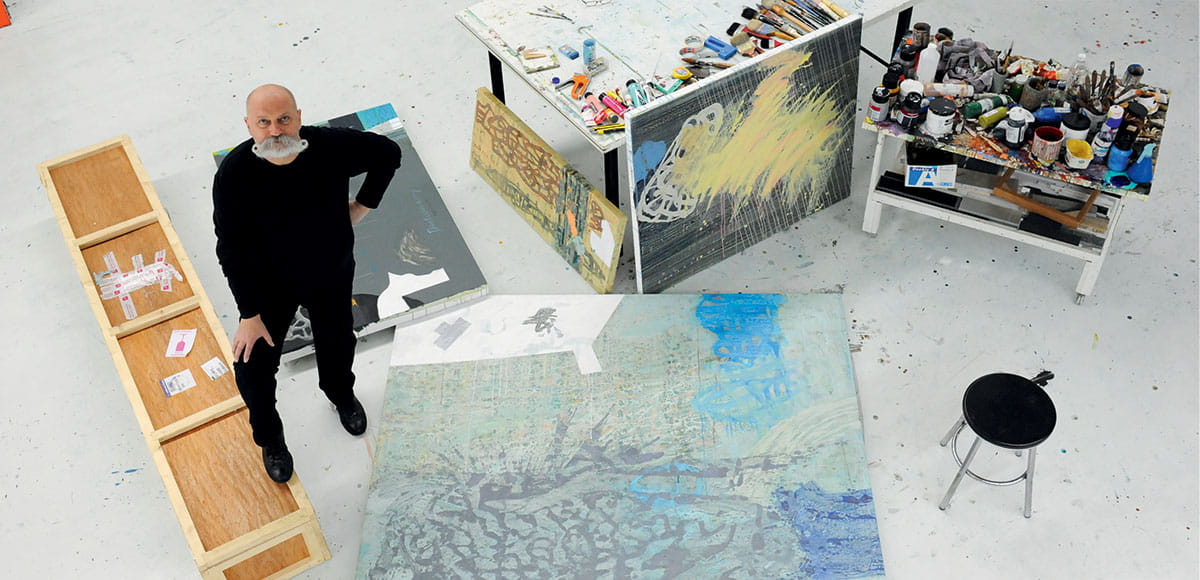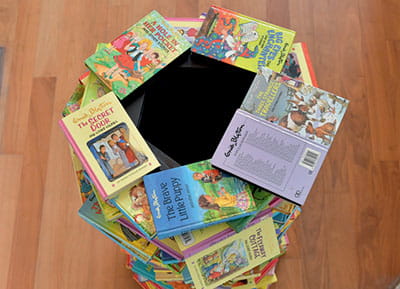Stories > Art of Healing
Art of Healing
An idea born in New York has grown to impact Japanese children with the help of a team of Singapore-based creatives and art therapists.
BY LOW SHI PING
PHOTOS SPH LIBRARY, LASALLE COLLEGE OF THE ARTS

Milenko Prvacki shows off the Miracle Kutchie Experienceʼs art therapy sessions venue – a large neutral space where the children have access to plenty of art materials.
n 2014, eight children from Hirono-town, Fukushima, Japan, arrived in Singapore. Having experienced the trauma of the earthquake and tsunami of 2011, during which their hometown was flooded, they had been invited to take part in a two-week art therapy programme to help them crystallise their thoughts and feelings and communicate these with others. The programme, led by Cultural Medallion winner and LASALLE College of the Arts Senior Fellow Milenko Prvacki, a naturalised Singaporean, was the Miracle Kutchie Experience.
Prvacki says: “I come from Yugoslavia, a country that doesn’t exist anymore. So I am familiar with tragedy and how it impacts children. I wanted to help.”
Miracle Kutchie is run by Today Is The Day (TITD), a non-profit group based in Japan, the United States, Singapore and Switzerland. Prvacki first heard about it in 2013 when Hirakawa Noritoshi, a renowned Japanese contemporary artist and TITD’s director, brought up the idea of running a Singapore programme to him. “Kutchie” (“plentiful” in the Fukushima dialect) was chosen as Hirakawa wanted to express the idea that the programme has great results. “Noritoshi wanted to run the Miracle Kutchie Experience in Singapore because it is safe, close to Japan, and has an art therapy masters programme,’’ says Prvacki.
Prvacki roped in Ronald Lay, programme leader of LASALLE’s Master of Arts in Art Therapy programme, who got his students to help design and implement the Miracle Kutchie Experience during the school’s mid-year break.
“The power of art therapy is that words do not need to be exchanged,” says Lay about his decision to get involved. “This is especially important with those who have experienced complex trauma, and children readily – oftentimes naturally – respond to art and art making.”
Hirakawa invited New York-based art therapist Kobayashi Toshiko to work with the principal of Hirono Elementary School in Fukushima to encourage its children to sign up.
STEADY GROWTH
The first cohort of children was sponsored by corporate, retail and private donors from Japan, the US, and Europe. Since 2014, 40 children have taken part in what has become an annual affair. This year, 20 children took part and the organisers believe this is the optimal number. Future groups will be capped at this figure.
Lay’s student volunteers have increased in number, too. In 2014, there were three; this year there were eight.
Says Lay, who is from Canada: “Children involved in this project are given opportunities to creatively express themselves in safe ways, in a fresh environment. Our goal is to make the children feel comfortable and safe, and develop the expressive and communicative skill sets necessary for further and in-depth therapy, upon return to Japan. We also hope to build their self-esteem and confidence, and improve their communication and social skills. Our student volunteers are intent on giving the children a great experience and a smoothly executed programme. That some of the children return year after year is an indication of the programme’s success.”
Since last year, Kobayashi has also actively followed up on the children’s progress after they return to Fukushima, working with their teachers to track their behaviour. She and Lay will be presenting a paper on the programme in November at the American Art Therapy Association’s annual conference, to raise awareness of and support for the programme.
“ Children involved in this project are given opportunities to creatively express themselves in safe ways, in a fresh environment. ”
Ronald Lay, Programme Leader of LASALLEʼs Master of Arts in Art Therapy programme
LEARNING ABOUT ONE ANOTHER
Miracle Kutchie’s core component is a twohour workshop run every weekday during the programme by Lay’s students and art therapists from Japan – the latter double as interpreters.
“We always start with a get-to-know-you session, to build friendship and trust between the student volunteers and the children. Then we have themed activities to elicit emotions from the children. This gets them to talk about how they feel,” Lay says.
Miracle Kutchie’s activities are designed to help the children learn more about themselves and others. It also equips them with communication methods and skills that will deepen their benefit from further, more in-depth therapy back home.
Student volunteer Chee Li Peng points to the changes that the children undergo as the programme unfolds. “They start communicating and collaborating more effectively with one another as well as with the facilitators, sharing materials and helping each other in the creation of their artwork,” she says.
This year, for example, the children were split Children who take part in the Miracle Kutchie Experience get to try a variety of craft-based and physical activities, both indoors and outdoors, as the programme facilitators aim to give them a range of ways to express themselves. into four groups of five and encouraged to develop identities by designing “clan armour”. They also had to complete team tasks, such as making musical instruments using recycled materials, and composing a music piece to perform together.
Lay says the musical exercise helped the children figure out their individual voices, allowing them to interact and engage on a more personal level. “They also learnt about taking turns, when they had to wait for other groups to perform,” he adds.
Chee noticed some children, who started out being reserved and apprehensive, becoming more engaged and confident, and eventually taking ownership of their creations. “Each of their artwork shows a great deal of engagement and responsiveness, which suggests a keen interest in the artmaking process, too.”
The close interaction helps participants connect with and better understand each other, making them more receptive to learning from and engaging with one another. The Japanese art therapists have taken home some new ideas and approaches from their Singaporean counterparts, such as the value of structured and guided sessions, while the Singaporeans have been encouraged to express themselves more freely.

Children who take part in the Miracle Kutchie Experience get to try a variety of craft-based and physical activities, both indoors and outdoors, as the programme facilitators aim to give them a range of ways to express themselves.
PATH TO RECOVERY
The programme usually ends with the children’s works being exhibited first at LASALLE, then back in their hometown. This year, the plan is to display them at a gallery in Tokyo too, as well as the public hall in Hirono-town in the autumn.
Lay says: “We give these children the opportunity to be children. You never know what seeds you are planting and where they will go.”
Prvacki agrees. “Many of the children had never left Japan before taking part in this programme. Singapore, via Miracle Kutchie, has given them a valuable experience. It is very important that they have mental and contemplative spaces they can retreat to, if they have problems in Japan. They will carry Singapore in their minds all their lives. “Back home, they close all their physical doors and windows; here, we open physical, emotional and mental doors and windows for them.”
THROUGH THE LOOKING GLASS
LASALLEʼs MA in Art Therapy programme is the only one of its kind in South-east Asia. Among its 2017 graduates is Pamela Lie, who created an artwork, Down The Rabbit Hole, to mark her courseʼs conclusion. The installation is made up of over 220 “unwanted” Enid Blyton books arranged to form a vertical tunnel.
Look at it from the si de and you might just spot familiar titles such as The Wishing Jug, The Flyaway Cottage and The Magic Clock. View it from the top, however, and a “rabbit hole” is evident. “It represents a journey into the unknown,” says Lie. “I was inspired and motivated by my therapy encounters with people living with depression.”
de and you might just spot familiar titles such as The Wishing Jug, The Flyaway Cottage and The Magic Clock. View it from the top, however, and a “rabbit hole” is evident. “It represents a journey into the unknown,” says Lie. “I was inspired and motivated by my therapy encounters with people living with depression.”
Her intent in using the books, some of which would have otherwise been discarded by a classmate, was to challenge her audience to view them “as objects to be seen, appreciated and accepted”. They simultaneously serve as a representation of the neglected, forgotten or abandoned stories from oneʼs life.
Down The Rabbit Hole mirrors Lieʼs own story. Two years ago, she had found herself increasingly disenchanted with life. The former sales executive then decided to rethink her lifeʼs purpose and help others. “I took a leap of faith and jumped into a rabbit hole of uncertainties, and ended up on an uncharted journey into art therapy.”
Today, Lie is in a much better place. She recognises that art is a powerful means to engage communities and cultures on mental health. “Barriers can be broken down through art, by clearing misunderstanding, fear, and prejudice.”
